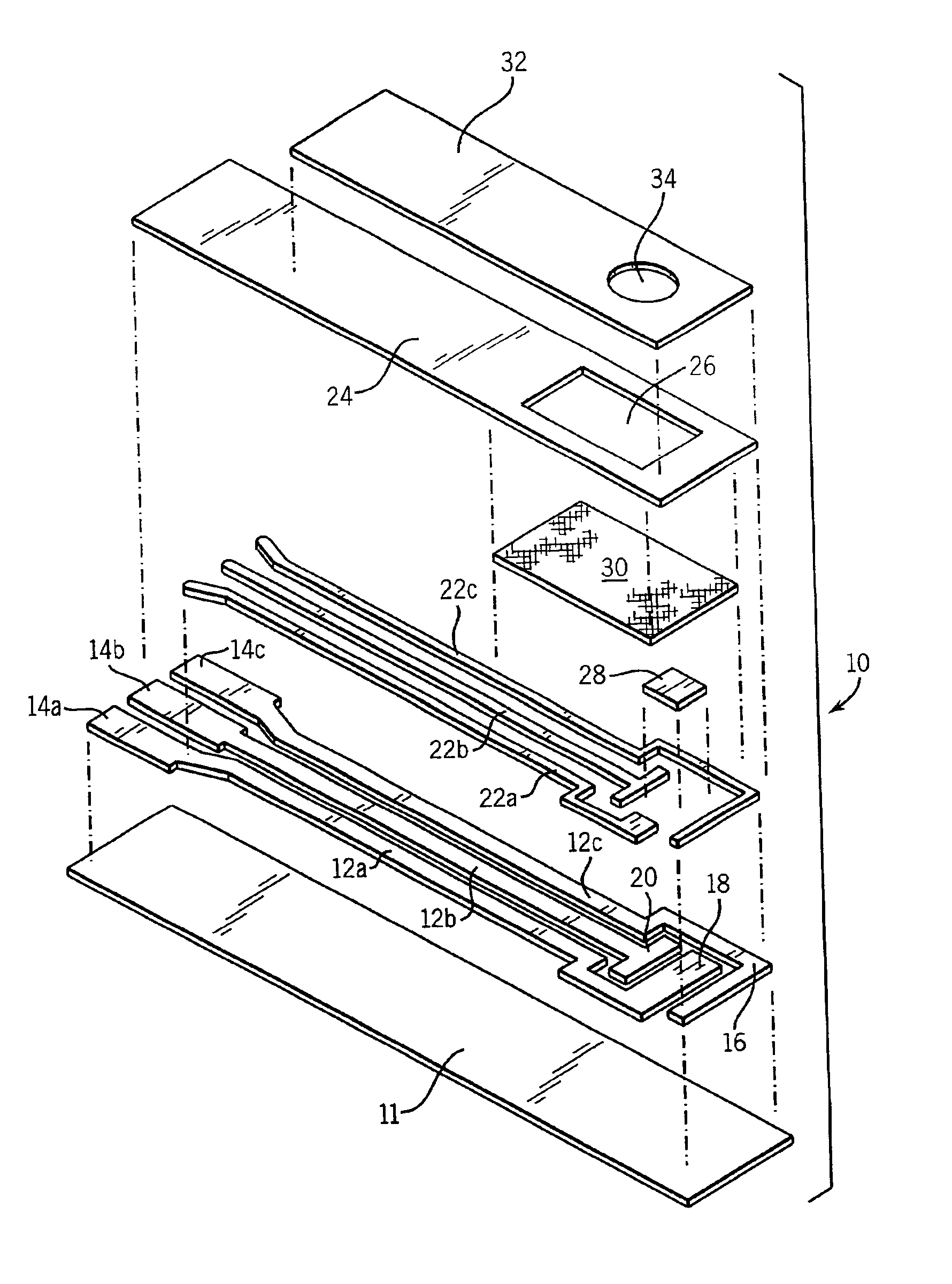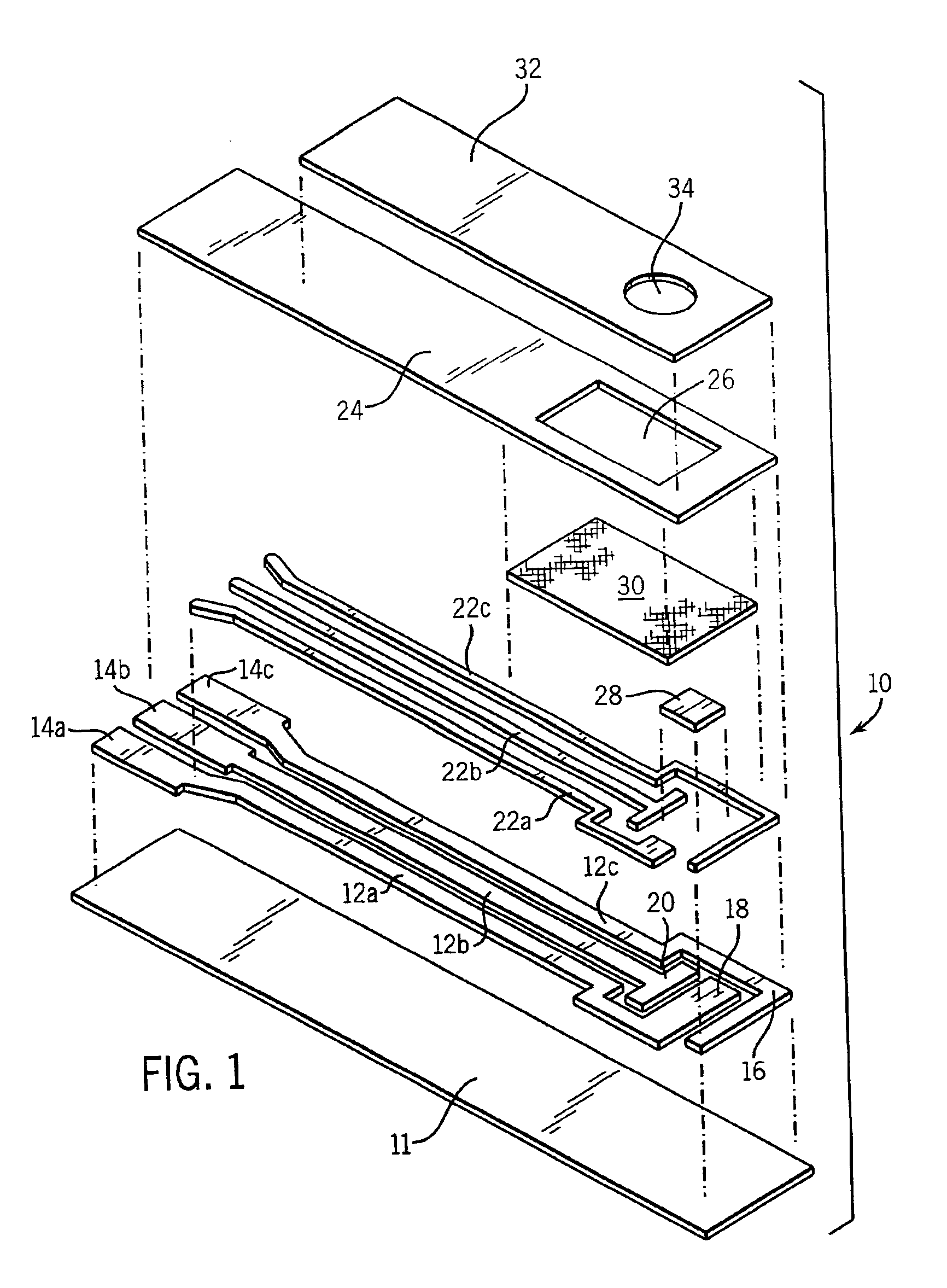Electrochemical biosensor strip for analysis of liquid samples
a biosensor and electrode technology, applied in the field of biosensors, can solve the problems of loss of voltage control the potential applied between the dual-purpose reference/counter electrode and the working electrode cannot be changed to compensate for the change in potential at the working electrode, and the inability to maintain a steady potential between the dual-purpose reference/counter electrode and the working electrode. to achieve the effect of facilitating sample transpor
- Summary
- Abstract
- Description
- Claims
- Application Information
AI Technical Summary
Benefits of technology
Problems solved by technology
Method used
Image
Examples
example 1
This example illustrates the chemical composition of a working ink for the measurement of the concentration of glucose.
In this example, the formulation of the working ink for the working electrode comprises, as active components, glucose dehydrogenase as the enzyme, a nicotinamide adenine dinucleotide as a coenzyme, and a phenanthroline quinone as the mediator. The inactive components include buffer (to maintain the pH during ink preparation), a binder (hydroxyethyl cellulose), a protein stabilizer (trehalose), a stabilizer for glucose dehydrogenase (bovine serum albumin), an antifoaming agent (clerol), a salt (magnesium chloride), and carbon (conducting particulate additive). Magnesium chloride aids the solubility of the mediator during reaction. Ranges of these ingredients that are suitable for this invention are shown in Table 1.
TABLE 1IngredientAmountEnzyme (such as glucose dehydrogenase or200 to 4000 Units3-hydroxybutyrate dehydrogenase)Nicotinamide coenzyme (such as NAD+)5 to ...
example 2
This example illustrates the chemical composition of a working ink for the measurement of the concentration of ketone bodies.
In this example, the formulation of the working ink for the working electrode comprises, as the active components, a 3-hydroxybutyrate dehydrogenase as the enzyme, a nicotinamide adenine dinucleotide as a coenzyme, and a phenanthroline quinone as the mediator. The inactive components include buffer (to maintain the pH during ink preparation), binder (guar gum), antifoaming agent (clerol), salt (magnesium chloride), carbon (conducting particulate additive), and a protein stabilizer. Ranges of concentrations of these ingredients per gram of the working ink that are suitable for this invention are also shown in Table 1.
example 3
This example illustrates another embodiment of the chemical composition of a working ink for the measurement of the concentration of glucose.
In this example, the formulation of the working ink for the working electrode comprises, as the active components, glucose oxidase as the enzyme and a ferrocene derivative as the mediator. The inactive components are buffer (to maintain the pH during the ink preparation), binders (polyvinyl alcohol, alginate), antifoaming agent (clerol), carbon (conducting particulate additive), and a protein stabilizer. Ranges of concentrations of these ingredients per gram of the working ink that are suitable for this invention are shown in Table 2.
TABLE 2IngredientAmountEnzyme (such as glucose oxidase)200-4000 unitsMediator (such as ferrocene; 4,7-0.1 to 1.5 weight percentphenanthroline quinone)Buffer50 to 100 mMAntifoaming agent2 to 4 weight percentFiller (such as ultra fine carbon or titania)10 to 30 weight percentBinder (such as alginate or guar gum,0.01 ...
PUM
| Property | Measurement | Unit |
|---|---|---|
| Force | aaaaa | aaaaa |
| Concentration | aaaaa | aaaaa |
| Electrical conductor | aaaaa | aaaaa |
Abstract
Description
Claims
Application Information
 Login to View More
Login to View More - R&D
- Intellectual Property
- Life Sciences
- Materials
- Tech Scout
- Unparalleled Data Quality
- Higher Quality Content
- 60% Fewer Hallucinations
Browse by: Latest US Patents, China's latest patents, Technical Efficacy Thesaurus, Application Domain, Technology Topic, Popular Technical Reports.
© 2025 PatSnap. All rights reserved.Legal|Privacy policy|Modern Slavery Act Transparency Statement|Sitemap|About US| Contact US: help@patsnap.com



